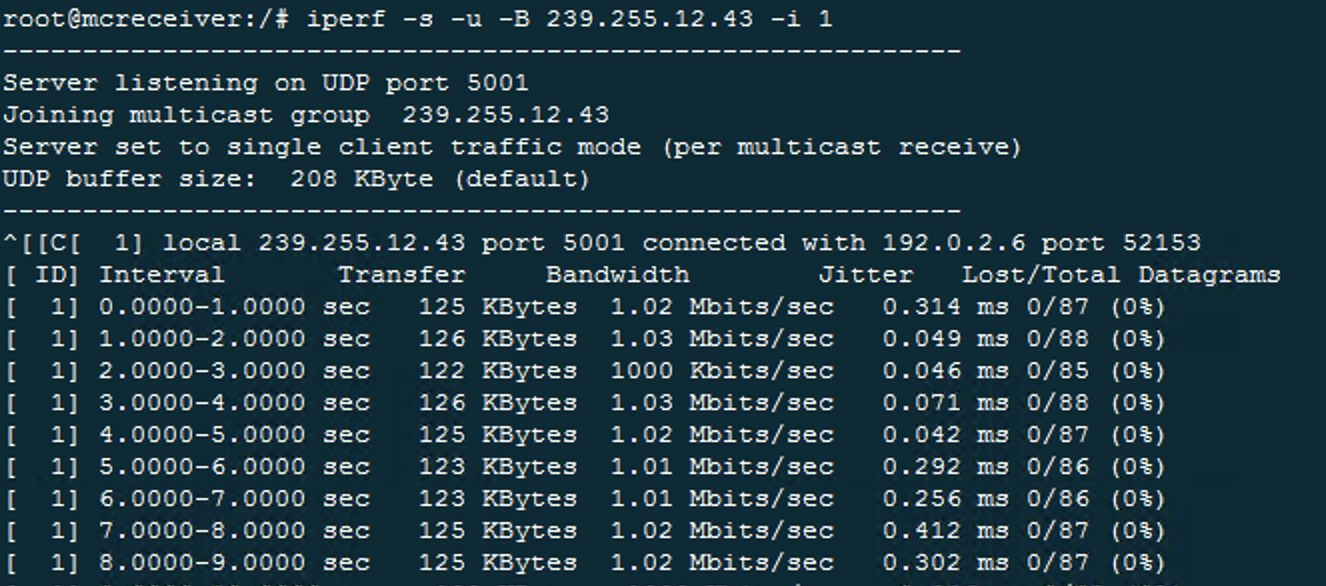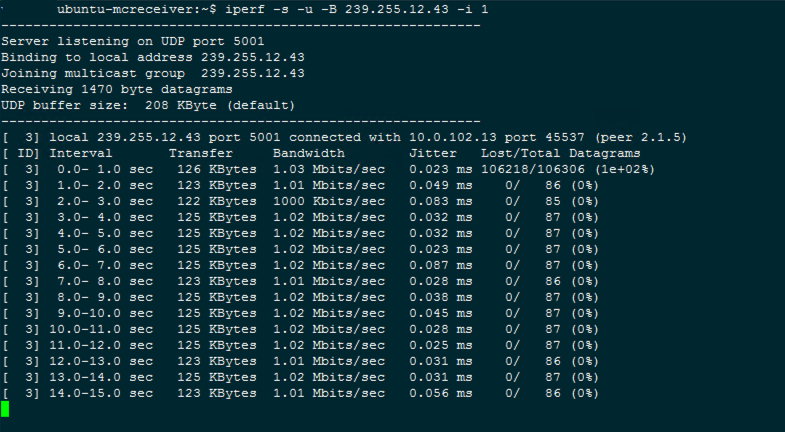Enabling Multicast on Tanzu TKGs with Antrea
I recently worked with a customer on testing multicast patterns (Pod -> Pod and Pod -> VM) on vSphere Tanzu TKGs with antrea. Antrea is an OSS Kubernetes CNI developed by VMware and is currently a CNCF sandbox project. The use case was around Tanzu Kuberntes Grid Supervisor (TKGs) which is Kubernetes integrated into vSphere.
Antrea CNI multicast support is Alpha, so the feature gate needs to be enabled to use it. This is normally done via an antrea-config configmap object. However TKGs supervisor controls these objects and setting the antrea-config cm directly will result in the changes being reverted by the supervisor. As of vSphere 8.0 update 1, you can create an AntreaConfig object that allows you to modify the configuration of Antrea per TKG workload cluster.
I’m not going to dig into vSphere with Tanzu components, setup or configuration. Please reference VMware’s official documentation to learn all about vSphere with Tanzu. Also note that Tanzu Kuberentes Grid with Standalone Management Cluster support directly editing the antrea-config configmap to change the Antrea configuration. Refer to Antrea upstream documents for that.
Test Setup
- vCenter 8.0u1c
- vSphere ESXi 8.0u1a
- Tanzu Kuberentes Grid (TKG) Supervisor enabled
- TKG v1.25 Ubuntu based Kuberentes Cluster
Note about versions: The antreaconfig object that is used to customize antrea feature gates was introduced in vSphere 8.0u1+. This allows you to manage the configmap that antrea uses for configuration per TKG workload cluster. Without getting too deep, you cannot just manually edit the antrea-config configmap on the TKG workload clusters becaause the antrea controller running on the supervisor cluster will overwrite those changes. This is a common pattern on TKG supervisor managed clusters. In vSphere 8.0u1 attempting to add the Multicast: true to the antreaconfig feature gate generated an error that Mulitcast featuregate was unknown. Because of this I put vSphere 8.0u1c as the version. It may work on older u1 versions.
Create the Antra Config in the vSphere Namespace where TKG cluster will be created
Create a vSphere namespace. I’m using the vsphere namespace mcast for this example
Change to mcast context kubectl config use-context mcast
Create a AntreaConfig object in the format of clustername-antrea-package in the vSphere namespace where cluster will be created.
- AntreaConfig required object name format
clustername-antrea-package - AntreaConfig Example Yaml File with
Multicast: trueandNetworkPolicyStats: true
cat <<EOF > mccluster-antrea-config.yaml
apiVersion: cni.tanzu.vmware.com/v1alpha1
kind: AntreaConfig
metadata:
name: mccluster-antrea-package
namespace: mcast
spec:
antrea:
config:
featureGates:
AntreaProxy: true
EndpointSlice: false
AntreaPolicy: true
FlowExporter: true
Egress: true
NodePortLocal: true
AntreaTraceflow: true
NetworkPolicyStats: true
Multicast: true
EOF
Create AntreaConfig kubectl apply -f mccluster-antrea-config.yaml
Validate AntreaConfig was created in vSphere namespace mccast kubectl get antreaconfig
Create TKG Workload Cluster
Next steps is to create the TKG Workload cluster in the mcast vSphere Namespace with the same name used as part of the antrea-package name. In our example this is mccluster (mccluster-antrea-package). The TKG v1.25 includes Antrea 1.9.0 which supports multicast with encap so this is why we want to use v1.25 TKR.
It is important to use the Ubuntu OS for the cluster instead of Photon. When testing with Photon the antrea-agent pods went into crash loopback with an error ‘failed to create multicast socket’ so it appears there is currently an issue with Photon.
Example Ubuntu v1.25 TKG Workload Cluster Manifest
apiVersion: cluster.x-k8s.io/v1beta1
kind: Cluster
metadata:
name: mccluster
namespace: mcast
spec:
clusterNetwork:
services:
cidrBlocks: ["198.51.100.0/12"]
pods:
cidrBlocks: ["192.0.2.0/16"]
serviceDomain: "cluster.local"
topology:
class: tanzukubernetescluster
version: v1.25.7---vmware.3-fips.1-tkg.1
controlPlane:
replicas: 1
metadata:
annotations:
run.tanzu.vmware.com/resolve-os-image: os-name=ubuntu
workers:
machineDeployments:
- class: node-pool
name: node-pool-1
replicas: 2
metadata:
annotations:
run.tanzu.vmware.com/resolve-os-image: os-name=ubuntu
variables:
- name: vmClass
value: best-effort-xsmall
- name: storageClass
value: vsan-default-storage-policy
- name: defaultStorageClass
value: vsan-default-storage-policy
- name: clusterEncryptionConfigYaml
value: |
apiVersion: apiserver.config.k8s.io/v1
kind: EncryptionConfiguration
resources:
- resources:
- secrets
providers:
- aescbc:
keys:
- name: key1
secret: QiMgakjdfajoifa99fa0dxxxx.dkaafad
- identity: {}
- Create Cluster
kubectl apply -f mccluster-classy.yaml - Authenticate to workload cluster using appropriate
kubectl vsphere logincommands - Change to workload cluster context
kubectl config use-context mccluster - Verify antrea-agent and antrea-controller pods are running
kubectl get po -n kube-system |grep antrea
antrea-agent-7xg5t 2/2 Running 0 46h
antrea-agent-f8m2d 2/2 Running 0 46h
antrea-agent-xqxk5 2/2 Running 0 46h
antrea-controller-689b7cdfc5-4p6r9 1/1 Running 0 46h
- Describe the antrea-configmap and verify Multicast and NetworkPolicyStats feature gates are set to true
kubectl describe cm antrea-config -n kube-system
antrea-controller.conf:
----
featureGates:
Traceflow: true
AntreaPolicy: true
NetworkPolicyStats: true
Multicast: true
antrea-agent.conf:
----
featureGates:
AntreaProxy: true
EndpointSlice: false
TopologyAwareHints: false
Traceflow: true
NodePortLocal: true
AntreaPolicy: true
FlowExporter: true
NetworkPolicyStats: true
Egress: true
AntreaIPAM: false
Multicast: true
- Exec into the antrea-agent and antrea-controller pods directly and use antctl to check status
kubectl exec -ti antrea-agent-xqxk5 -n kube-system -- sh
# antctl get featuregates
Antrea Agent Feature Gates
FEATUREGATE STATUS VERSION
AntreaProxy Enabled BETA
NodePortLocal Enabled BETA
TopologyAwareHints Disabled ALPHA
AntreaIPAM Disabled ALPHA
NodeIPAM Disabled ALPHA
Multicluster Disabled ALPHA
ExternalNode Disabled ALPHA
AntreaPolicy Enabled BETA
Traceflow Enabled BETA
TrafficControl Disabled ALPHA
Egress Enabled BETA
EndpointSlice Disabled ALPHA
FlowExporter Enabled ALPHA
NetworkPolicyStats Enabled BETA
Multicast Enabled ALPHA
## Create Containers to test Mutlicast
I’m using simple iperf to test Mutlicast sending / receiver. I put together a couple simple Dockefiles to acheive this
### Sender Dockerfile
mkdir sender
cd sender
cat <<EOF > Dockerfile
FROM ubuntu
RUN apt-get update
RUN apt-get install -y tcpdump
RUN apt-get install -y iputils-ping
RUN apt-get install -y iputils-tracepath
RUN apt-get install -y iproute2
RUN apt-get install -y iperf
ENTRYPOINT ["/usr/bin/iperf", "-c", "239.255.12.43", "-u", "-T", "32", "-t", "86400"]
EOF
Receiver Dockerfile
mkdir receiver
cd reciever
cat <<EOF > Dockerfile
FROM ubuntu
RUN apt-get update
RUN apt-get install -y tcpdump
RUN apt-get install -y iputils-ping
RUN apt-get install -y iputils-tracepath
RUN apt-get install -y iproute2
RUN apt-get install -y screen
RUN apt-get install -y iperf
ENTRYPOINT ["/usr/bin/iperf", "-s", "-u", "-B", "239.255.12.43", "-i", "1"]
EOF
- Build the docker images with approriate tags to your image registry and push them
docker build . -t registry/project/mcreceiver:v1
Testing Pod-to-Pod Multicast - Same Cluster
Create Pod Manifests
Sender Pod
cat <<EOF > mcsender.yaml
apiVersion: v1
kind: Pod
metadata:
labels:
run: mcsender
name: mcsender
namespace: default
spec:
containers:
- image: {registry-fqdn}/mcsender:v1
imagePullPolicy: IfNotPresent
name: mcsender
EOF
Receiver Pod
cat <<EOF > mcreceiver.yaml
apiVersion: v1
kind: Pod
metadata:
labels:
run: mcreceiver
name: mcreceiver
namespace: default
spec:
containers:
- image: {registry-fqdn}/mcreceiver:v1
imagePullPolicy: IfNotPresent
name: mcreceiver
EOF
Deploy Pods
kubectl apply -f mcsender.yaml
kubectl apply -f mcreceiver.yaml
Verify Multicast Traffic
The mcsender should already be sending traffic since the entrypoint of the container is running the iperf command. To validate mutlticast traffic is working you can exec to the mcreceiver pod and manually run the iperf receiver commands to subscribe to the stream being sent by the mcsender.
Start Sender manually
- Exec to mcsender pod
kubectl exec -ti mcsender -- /bin/bash
- On the sender pod run
iperf -c 239.255.12.43 -u -T 32 -t 86400
Start Receiver manually
- Exec to mcreceiver pod
kubectl exec -ti mcreceiver -- /bin/bash
- On receiver pod run
iperf -s -u -B 239.255.12.43 -i 1
- If mutlicast is working you should see something like this

Check multicastgroups from K8s cli
kubectl get multicastgroups
GROUP PODS
239.255.12.43 default/mcreceiver
Check podmulticaststats on antrea-agent pods
- Exec into antrea-agent pods and view mulicast groups. Note: you will only see information on the pods running on the same K8s node as the antrea-agent
antrea-agent podmulticaststats for mcreceiver
kubectl exec -ti antrea-agent-7xg5t -n kube-system -- sh
antctl get podmulticaststats
NAMESPACE NAME INBOUND OUTBOUND
default mcreceiver 827309 0
kube-system metrics-server-588ff6d9b4-tlwpm 0 0
secretgen-controller secretgen-controller-75d88bc999-m7zkh 0 0
antrea-agent podmulticaststats for mcsender
kubectl exec -ti antrea-agent-xqxk5 -n kube-system -- sh
antctl get podmulticaststats
NAMESPACE NAME INBOUND OUTBOUND
default mcsender 0 450370
Checking mulicast from VM or K8s node
- ssh to VM or K8s node
ip mroute
(192.0.1.5,239.255.12.43) Iif: antrea-gw0 Oifs: eth0 State: resolved
Testing Pod-to-VM Multicast
I initially had problems getting Pod -> VM multicast working without using hostNetwork for the sender pod. Talking with some of the Antrea engineers they said it should work with the CNI network and I should not need hostNetwork. After some checking they determined my traffic was timing out before it got to the VM and I needed to adjust my iperf command on the sender to use -T 32. Once I made this change it worked as expected.
The VM I’m testing is on the same subnet as my K8s cluster. To route multicast across vlans you may need additional configuration on the physical network to set up PIM and other multicast forwarding configurations. That’s out of the scope of this document (mainly because my home lab gear doesn’t support this). I may test in my nested environments to see if I can get it working.
To test just use any VM with iperf installed and run the same iperf command as you do on the receiver pod
iperf -s -u -B 239.255.12.43 -i 1
If multicast is working should see something like this

Disclaimer: All posts, contents and examples are for educational purposes only and does not constitute professional advice. No warranty and user excepts All information, contents, opinions are my own and do not reflect the opinions of my employer. Most likely you shouldn’t listen to what I’m saying and should close this browser window immediately
